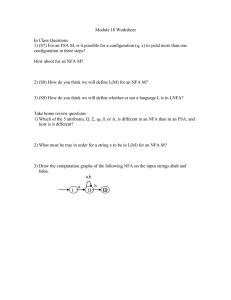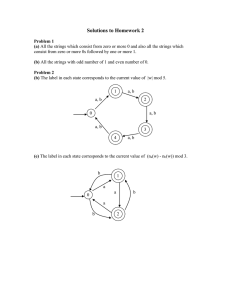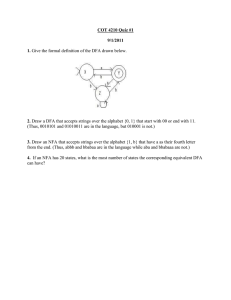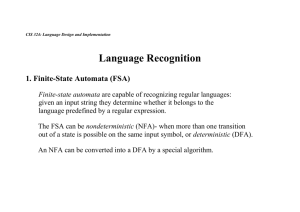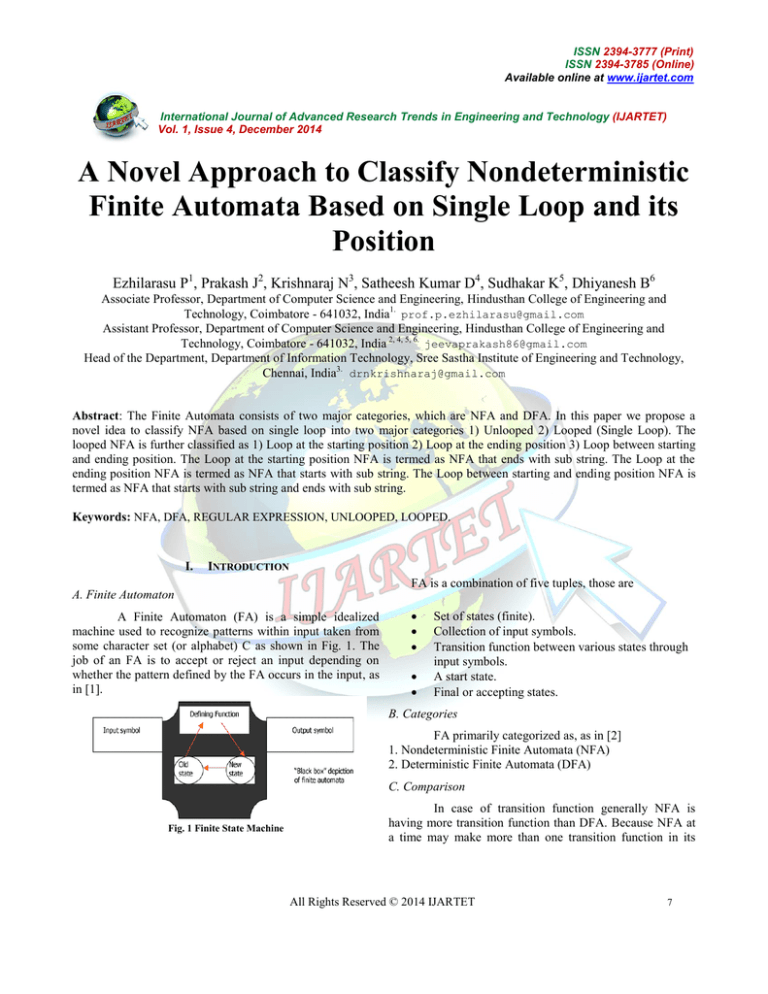
ISSN 2394-3777 (Print)
ISSN 2394-3785 (Online)
Available online at www.ijartet.com
International Journal of Advanced Research Trends in Engineering and Technology (IJARTET)
Vol. 1, Issue 4, December 2014
A Novel Approach to Classify Nondeterministic
Finite Automata Based on Single Loop and its
Position
Ezhilarasu P1, Prakash J2, Krishnaraj N3, Satheesh Kumar D4, Sudhakar K5, Dhiyanesh B6
Associate Professor, Department of Computer Science and Engineering, Hindusthan College of Engineering and
Technology, Coimbatore - 641032, India1. prof.p.ezhilarasu@gmail.com
Assistant Professor, Department of Computer Science and Engineering, Hindusthan College of Engineering and
Technology, Coimbatore - 641032, India 2, 4, 5, 6. jeevaprakash86@gmail.com
Head of the Department, Department of Information Technology, Sree Sastha Institute of Engineering and Technology,
Chennai, India3. drnkrishnaraj@gmail.com
Abstract: The Finite Automata consists of two major categories, which are NFA and DFA. In this paper we propose a
novel idea to classify NFA based on single loop into two major categories 1) Unlooped 2) Looped (Single Loop). The
looped NFA is further classified as 1) Loop at the starting position 2) Loop at the ending position 3) Loop between starting
and ending position. The Loop at the starting position NFA is termed as NFA that ends with sub string. The Loop at the
ending position NFA is termed as NFA that starts with sub string. The Loop between starting and ending position NFA is
termed as NFA that starts with sub string and ends with sub string.
Keywords: NFA, DFA, REGULAR EXPRESSION, UNLOOPED, LOOPED.
I.
INTRODUCTION
FA is a combination of five tuples, those are
A. Finite Automaton
A Finite Automaton (FA) is a simple idealized
machine used to recognize patterns within input taken from
some character set (or alphabet) C as shown in Fig. 1. The
job of an FA is to accept or reject an input depending on
whether the pattern defined by the FA occurs in the input, as
in [1].
Set of states (finite).
Collection of input symbols.
Transition function between various states through
input symbols.
A start state.
Final or accepting states.
B. Categories
FA primarily categorized as, as in [2]
1. Nondeterministic Finite Automata (NFA)
2. Deterministic Finite Automata (DFA)
C. Comparison
Fig. 1 Finite State Machine
In case of transition function generally NFA is
having more transition function than DFA. Because NFA at
a time may make more than one transition function in its
All Rights Reserved © 2014 IJARTET
7
ISSN 2394-3777 (Print)
ISSN 2394-3785 (Online)
Available online at www.ijartet.com
International Journal of Advanced Research Trends in Engineering and Technology (IJARTET)
Vol. 1, Issue 4, December 2014
state. But DFA can make maximum one transition function
Henning Bordihn et. al. [2006] defined Extended finite
in its state.
automata as finite state automata equipped with the
additional ability to apply an operation on the currently
D. Problem
remaining input word, depending on the current state.
The general problem in FA is construction of Hybrid extended finite automata can choose from a finite set
minimized DFA from the given regular expression, as in [3], of such operations, as in [11].
[4], [5] and [6].
Hing Leung [2006] defined a structurally unambiguous
Construction of NFA is less complex as compared finite automaton (SUFA) to be a nondeterministic finite
automaton (NFA) with one starting state q0 such that for all
to construction of DFA, as in [7] and [8].
input strings w and for any state q, there is at most one path
For Example.
from q 0 to q that consumes w. The definition of SUFA
Regex: (a)*|(a)*
differs from the usual definition of an unambiguous finite
Regex length: 9
automaton (UFA) in that the new definition is defined in
Regex to NFA loops: 4
terms of the transition logic of the finite automaton, and is
Number of NFA nodes: 8
independent of the choice of final states, as in [14].
NFA to DFA loops: 12
III. ABOUT NFA CLASSIFICATION
Number of unminimised DFA nodes: 2
Minimize DFA loop: 1
The non deterministic finite automata can be broadly
Number of minimized DFA nodes: 2
classified into looped and unlooped NFA as shown in Fig. 2.
DFA to regex loops: 5
E. Steps
Steps for converting Regular Expression into minimized
DFA, as in [9].
1. Convert Regular expression into epsilon NFA using
Thompson algorithm.
2. Convert Epsilon NFA into NFA
3. Convert NFA into DFA.
4. Minimize the obtained DFA using minimization
algorithm.
II. RELATED WORKS
Juraj Hromkovic et. al. [1997] described a language
L(n) by a regular expression of size O(n) such that every
NFA accepting L(n) is of size (n log n), as in [10].
Fig. 2 Types of NFA
IV. UNLOOPED
Yongzhi Cao and Yoshinori Ezawa [2012] generalized
nondeterministic finite automata into fuzzy automata to
In this type, NFA doesn’t contain any loop. The
handle fuzzy uncertainty in system modeling. They input string will end with accepting state without any loop.
categorized nondeterministic fuzzy automata into
(deterministic) fuzzy automata, nondeterministic fuzzy
automata, and nondeterministic fuzzy automata with ϵmoves by providing a mathematical representation of
nondeterministic dynamic fuzzy systems, as in [11].
Jan Holub and borivoj Melichar [1999] categorized
NFA into two types. The first one is the transformation to
the equivalent deterministic finite automaton and the second
one is the simulation of the run of NFA, as in [11].
Fig. 3 General form of unlooped NFA
All Rights Reserved © 2014 IJARTET
8
ISSN 2394-3777 (Print)
ISSN 2394-3785 (Online)
Available online at www.ijartet.com
International Journal of Advanced Research Trends in Engineering and Technology (IJARTET)
Vol. 1, Issue 4, December 2014
GENERAL FORMAT: Sub string with No loop as shown in number of input string to reach accepting state. Once it
Fig. 3.
reached the accepting state it will remain in same state.
Ex. A NFA that accepts a string aba over {a,b}.
Fig. 4 Example for General form of unlooped NFA
V. LOOPED
Fig. 7 General form of looped NFA, loop between start and end of NFA
The NFA that contains loops are broadly classified GENERAL FORMAT: Sub string + Self loop + Sub string
as 1) Loop at the end, 2) Loop between start and end, 3) as shown in Fig. 7.
Ex. A NFA that accepts a string that starts with a sub string
Loop at the start.
ab and ends with a sub string a over {a,b}.
A. Loop at the End
In this type of NFA the loop is present at the ending
state. That means it can have any number of input character
before the accepting state. Once it reached the accepting
state it will remain in same state and it will process the
remaining inputs in the accepting state itself.
Fig. 8 Example for General form of looped NFA, loop
between start and end of NFA
C.Loop at the Start
In this type of NFA the loop is present at the
starting state. That means it can have any number of input
character at starting state. After start state it will process
Fig. 5 General form of looped NFA, loop at the end
some finite number of input character then it will reach
state.
GENERAL FORMAT: Sub string + Self loop at the end accepting
position as shown in Fig. 5.
Ex. A NFA that accepts a string that starts with a sub string
aba over {a,b}.
Fig. 9 General form of looped NFA, loop at the start
GENERAL FORMAT: Self loop at the starting position +
Sub string as shown in Fig. 9.
Fig. 6. Example for General form of looped NFA, loop at the Ex. A NFA that accepts a string that ends with a sub string
end.
aba over {a,b}.
B.Loop Between Start And End
In this type of NFA the loop is present in between
the starting state and ending state of the string. That means it
can have any number of input character before the loop get
started and it will process any number of input character
within same state and finally it will process some finite
All Rights Reserved © 2014 IJARTET
9
ISSN 2394-3777 (Print)
ISSN 2394-3785 (Online)
Available online at www.ijartet.com
International Journal of Advanced Research Trends in Engineering and Technology (IJARTET)
Vol. 1, Issue 4, December 2014
[12]. Jan Holub and borivoj Melichar [1999]. “Implementation of
Nondeterministic Finite Automata for Approximate Pattern
Matching”, Automata Implementation Lecture Notes in
Computer Science Volume 1660, 1999, pp 92-99.
Fig. 10 Example for General form of looped NFA, loop at the start
VI. CONCLUSION
Based on single loop and three positions (start, end,
between start and end) NFA can be classified into three
categories as starting condition, ending condition and
starting as well as ending condition.
[13]. Henning Bordihn, Markus Holzer and Martin Kutrib [2006].
Hybrid Extended Finite Automata implementation and
Application of Automata Lecture Notes in Computer Science
Volume 4094, 2006, pp 34-45.
[14]. Hing Leung [2006]. “Structurally Unambiguous Finite
Automata”, implementation and Application of Automata
Lecture Notes in Computer Science Volume 4094, 2006, pp 198207.
VII. FUTURE WORK
This classification further can be extended by using
double loop at various positions.
REFERENCE
[1]. http://www.cs.rochester.edu/~nelson/courses/csc_173/fa/fa.html
[2]. https://www.cs.umd.edu/class/fall2014/cmsc330/lectures/05automata2.pdf
[3]. Berry, G. and R. Sethi [1986]. “From regular expressions to
deterministic automata”. Theoretical Computer Science. vol. 48,
no. 1, pp. 117-126.
[4]. Bruggemann-Klein A. [1993]. “Regular expressions into finite
automata”. Theoretical Computer Science. vol. 120, no. 2, pp.
197-213.
[5]. Chang, C. H. and R. Paige [1992]. “From regular expressions to
DFAs using compressed NFAs”. In Proceedings of the 3rd
Annual Symposium on Combinatorial Pattern Matching. Lecture
notes in Computer Science no. 644. Springer-Verlag, London.
pp. 90-110.
[6]. Hopcroft, J. E. and J. Ullman [1979]. Introduction to Automata
Theory, Languages and Computation. Addison-Wesley
Longman Publishing Company, Inc. Boston, MA, USA.
[7]. http://regex-automaton.com/complexity.php
[8]. http://www.cs.uml.edu/~giam/91.304/Lectures/1-2.pdf
[9]. Introduction to Automata Theory, Languages, and Computation
John E. Hopcroft , Rajeev Motwani Jeffrey D. Ullman Prentice
Hall; 3 edition (29 June 2006).
[10]. Juraj Hromkovic , Sebastian Seibert and Thomas Wilke [1997].
“ translating regular expression into small epsilon-free non
deterministic Automata” STACS '97 Proceedings of the 14th
Annual Symposium on Theoretical Aspects of Computer
Science Pages 55-66.
[11]. Yongzhi Cao and Yoshinori Ezawa [2012]. “Nondeterministic
fuzzy automata”, Information Sciences, Volume 191, 15 May
2012, Pages 86–97.
All Rights Reserved © 2014 IJARTET
10

